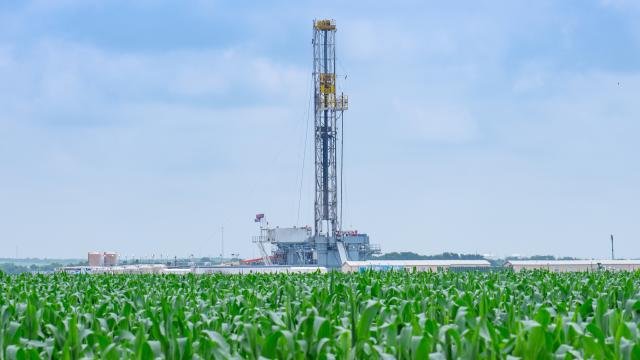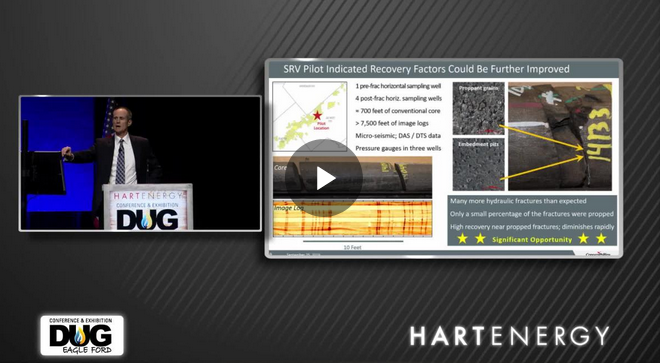
SAN ANTONIO—Robust data analytics, thoughtful completions evolution and other lessons learned after a decade operating in the Eagle Ford shale of South Texas has supermajor ConocoPhillips confident it has unlocked over one billion additional barrels of oil equivalent across its position since 2012.
The company entered the Eagle Ford in 2009 and currently holds around 200,000 net acres spanning from the updip black oil window and the downdip to the edge of the wet gas window. At the end of 2018, the operator had more than 1,200 wells and 2,000 miles of pipelines across the area.

Data gathering and analysis across its holdings has paid benefits, according to Erec Isaacson, vice president of ConocoPhillips’ Gulf Coast Business unit.
“With all of that information what we’ve been able to do from 2014-2018 is decrease or spud to total depth time by 33%, normalized to 10,000 feet,” he told attendees at Hart Energy’s DUG Eagle Ford conference and exhibition in San Antonio on Sept. 25. “That puts us at the front of the pack in terms of drilling efficiency as compared to our peer group. We don’t stop there with our use of data analytics. We also use it in our completions. We take all of our completion parameters and compare those to how they perform from the production of the well. We end up modifying and continuously optimizing our completions.”
RELATED: DUG Eagle Ford: Assets, Efficiency, Costs And Keys To Success
Studying completion techniques over time, ConocoPhillips was able to confirm not only that its fracking method created more fractures than originally predicted, but also only a small percentage of the overall fractures were effectively propped. Some of the proppant was embedded and some was flushed away while others simply never reached the fractures. Monitors installed in the wells revealed high recovery next to the fractures that were propped, but away from those the wells experienced very little pressure drop and very low recovery.

“Back in 2012, we were going out and putting nearly four million pounds of proppant in the ground at a 70-foot cluster spacing,” Isaacson said. “Over the five year period, we continuously updated our completion method. By 2017, we were putting 14 to 17 million pounds of proppant into the ground with a 15-foot cluster spacing—so much higher frac intensity. We were also customizing that across the Eagle Ford depending on what the geology looked like. Depending on where we are in the different phases of liquids in the subsurface—black oil or wet gas.”
RELATED VIDEO: DUG Eagle Ford: Well Interference, Focus On Drilling Inventories
Another important tool in the operator’s Eagle Ford tool belt has been the refrac. The company has gone back to refrac some of those early wells with its updated completion styles, getting a lot more out of the ground.
“We’re seeing refraced production coming in higher than the initial production on the well,” said Isaacson. “We’re seeing that repeated. When you look at our inventory, we have around 600 wells that we feel were sub-optimally completed that we could go back and refrac. On average, we’re seeing a 60% uplift in resource after the refrac.”
The impact of the refrac doesn’t end there. ConocoPhillips has also used refracs to assist in minimizing parent/child well interaction—one of the hot topics in the industry these days. When a parent is drilled it creates a pressure sink or low pressure zone around it. Drilling nearby infill wells can distort the child well frac towards that pressure sink.
“What we’re doing, in that parent well we are doing a defensive refract,” Isaacson explained.
“Normalizing that pressure field when we go in and drill those infill wells and we stimulate those, we don’t have as much of an impact.”
The operator is also refining enhanced oil recovery (EOR) methods in the Eagle Ford in an effort to maximize production. It currently has a trio of pilot programs ongoing in the area deploying huff-and-puff gas injection.
“One thing we’re doing during our EOR pilots, again, its gathering data,” said Isaacson. “Data that we can use to advance the technology, to innovate as we’re going through our EOR processes. We’re gathering data so we can understand what mechanisms are impacting EOR most for us in the various areas of our Eagle Ford field, whether its fracture redilation, hydrocarbon stripping or miscible fluid interaction. We’re gathering data so we can better understand that.”
Recommended Reading
Halliburton’s Low-key M&A Strategy Remains Unchanged
2024-04-23 - Halliburton CEO Jeff Miller says expected organic growth generates more shareholder value than following consolidation trends, such as chief rival SLB’s plans to buy ChampionX.
Deepwater Roundup 2024: Americas
2024-04-23 - The final part of Hart Energy E&P’s Deepwater Roundup focuses on projects coming online in the Americas from 2023 until the end of the decade.
Ohio Utica’s Ascent Resources Credit Rep Rises on Production, Cash Flow
2024-04-23 - Ascent Resources received a positive outlook from Fitch Ratings as the company has grown into Ohio’s No. 1 gas and No. 2 Utica oil producer, according to state data.
E&P Highlights: April 22, 2024
2024-04-22 - Here’s a roundup of the latest E&P headlines, including a standardization MoU and new contract awards.
Technip Energies Wins Marsa LNG Contract
2024-04-22 - Technip Energies contract, which will will cover the EPC of a natural gas liquefaction train for TotalEnergies, is valued between $532 million and $1.1 billion.





